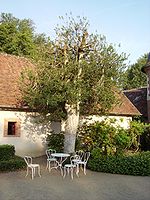
Château de Troussay
Encyclopedia

Châteaux of the Loire Valley
The châteaux of the Loire Valley are part of the architectural heritage of the historic towns of Amboise, Angers, Blois, Chinon, Nantes, Orléans, Saumur, and Tours along the Loire River in France...
, and is situated in Cheverny
Cheverny
Cheverny is a commune in the Loir-et-Cher département in central France.It lies in the Loire Valley, about southeast of Blois.The commune is the site of the Château de Cheverny....
, in the Loir-et-Cher
Loir-et-Cher
Loir-et-Cher is a département in north-central France named after the rivers Loir and Cher.-History:Loir-et-Cher is one of the original 83 departments created during the French Revolution on 4 March 1790. It was created from parts of the former provinces of Orléanais and...
.
History
If the first stone of the mansionMansion
A mansion is a very large dwelling house. U.S. real estate brokers define a mansion as a dwelling of over . A traditional European mansion was defined as a house which contained a ballroom and tens of bedrooms...
was placed around 1450, the oldest existing parts of the structure date from the Renaissance
Renaissance
The Renaissance was a cultural movement that spanned roughly the 14th to the 17th century, beginning in Italy in the Late Middle Ages and later spreading to the rest of Europe. The term is also used more loosely to refer to the historical era, but since the changes of the Renaissance were not...
. This is when Robert de Bugy, director of the salt storehouses of the region of Blois
Blois
Blois is the capital of Loir-et-Cher department in central France, situated on the banks of the lower river Loire between Orléans and Tours.-History:...
and squire of King Francis I of France
Francis I of France
Francis I was King of France from 1515 until his death. During his reign, huge cultural changes took place in France and he has been called France's original Renaissance monarch...
was the feudal lord.
In the 17th century, the domain was increased, and equipped with common areas and two wings, while a magnificent formal garden was laid out behind. In 1732, for the first time, the building changed owners: the last demoiselle de Bugy sold the château to the Pelluys family. After passing through various owners, Troussay arrived finally, in 1828, in the possession of Louis de la Saussaye, historian of the Loire châteaux, member of the Institut de France
Institut de France
The Institut de France is a French learned society, grouping five académies, the most famous of which is the Académie française.The institute, located in Paris, manages approximately 1,000 foundations, as well as museums and chateaux open for visit. It also awards prizes and subsidies, which...
, rector of the académies of Lyon and of Poitiers... This great scholar, acknowledging the problems of conservation and safeguard of inheritance due to his friendship with Prosper Mérimée
Prosper Mérimée
Prosper Mérimée was a French dramatist, historian, archaeologist, and short story writer. He is perhaps best known for his novella Carmen, which became the basis of Bizet's opera Carmen.-Life:...
and Felix Duban
Félix Duban
Jacques Félix Duban was a French architect, the contemporary of Jacques Ignace Hittorff and Henri Labrouste.Duban won the Prix de Rome in 1823, the most prestigious award of the École des Beaux-Arts...
, entirely restored the domain from its fallen state, according to his own statements "fort à l'abandon"..
After his death in 1900, the château was sold a second time to the family of the current owners, not wanting to move away from the Château de Cheverny
Château de Cheverny
The Château de Cheverny is located at Cheverny, in the département of Loir-et-Cher in the Loire Valley in France.-History:The lands were purchased by Henri Hurault, comte de Cheverny, a lieutenant-general and military treasurer for Louis XI, whose descendent the marquis de Vibraye is the present...
, the owners have remained the same family.
Façade of François I
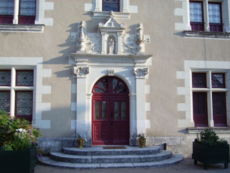
Château de Chambord
The royal Château de Chambord at Chambord, Loir-et-Cher, France is one of the most recognizable châteaux in the world because of its very distinct French Renaissance architecture which blends traditional French medieval forms with classical Renaissance structures.The building, which was never...
. Thus, in the central body, there are incrustations of slate
Slate
Slate is a fine-grained, foliated, homogeneous metamorphic rock derived from an original shale-type sedimentary rock composed of clay or volcanic ash through low-grade regional metamorphism. The result is a foliated rock in which the foliation may not correspond to the original sedimentary layering...
in the chimneys and also menaux in the windows. And the towers, though they are later, of the 18th century, are equipped with pinnacles, as at Chambord.
If the wing of right-hand side sheltered domestic activities—the baker's oven, hay loft, and stable with asses—the other was dedicated to the grand salon. It is not however that which explains the asymmetry: the left wing was rebuilt in the 19th century, at the time of Saussaye's restoration, unlike the wing on the right.
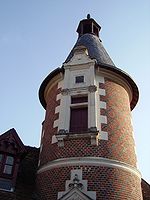
One also notes the presence of a sundial, on the right-hand tower, surrounded by an inscription in Latin: Ultimam time, fuit hora, carpe diem, meaning "fear the last hour, time flees, seize the day". Opposite this, is a clock with a single hour hand.
Façade of Louis XII
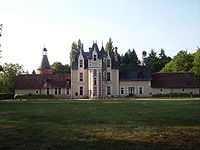
Linenfold
Linenfold is a simple style of relief carving used to decorate wood panelling with a design "imitating window tracery", "imitating folded linen" or "stiffly imitating folded material". Originally from Flanders, the style became widespread across Northern Europe in the 14th to 16th centuries...
panels remain still completely Gothic. The most beautiful example of this mixture is on the door of the tower, the old principal door of the château moved from the façade of François I by Louis de la Saussaye because of its small size. One finds linenfold there too, a Gothic motif par excellence, but also, on the door stop, a salamander
Salamander
Salamander is a common name of approximately 500 species of amphibians. They are typically characterized by a superficially lizard-like appearance, with their slender bodies, short noses, and long tails. All known fossils and extinct species fall under the order Caudata, while sometimes the extant...
, an emblem of François I. Above, Louis de la Saussaye had engraved, in Greek, this sentence ascribed to the general Themistocles
Themistocles
Themistocles ; c. 524–459 BC, was an Athenian politician and a general. He was one of a new breed of politicians who rose to prominence in the early years of the Athenian democracy, along with his great rival Aristides...
: "Small is the house, but oh how much happiness, if it is filled with friends."
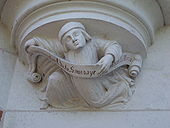
Château de Blois
The Royal Château de Blois is located in the Loir-et-Cher département in the Loire Valley, in France, in the center of the city of Blois. The residence of several French kings, it is also the place where Joan of Arc went in 1429 to be blessed by the Archbishop of Reims before departing with her...
, it shares their most notable characteristic- lattices of red and black bricks. Above a François I shell, a small marmouset commemorates the construction by deploying a banner on which the following is translated from Latin: "united by friendship, Louis de la Saussaye wanted, Jules de la Morandière realized". Other older sculptures were encrusted on a lathe, in particular a porcupine
Porcupine
Porcupines are rodents with a coat of sharp spines, or quills, that defend or camouflage them from predators. They are indigenous to the Americas, southern Asia, and Africa. Porcupines are the third largest of the rodents, behind the capybara and the beaver. Most porcupines are about long, with...
, emblem of Louis XII, coming from l'hôtel Hurault de Cheverny in Blois, and two sottise characters, the pope of fools and the insane mother.
Interior
The castle being private and inhabited, only six rooms on the ground floor are open to visitors:- the dining room
- the vestibule
- the music room, or salon Louis de la Saussaye
- the small salon
- the oval salon
- the oratory
One notes first of all the presence of the red and yellow tiling of time of Louis XII that covered the entirety of the ground floor formerly; it was removed only in the oval salon, at the time of its restoration.
The ceilings are of variable interest: in the dining room, the ceiling à la française is inspired by the example of the François I wing of the Castle of Blois, while in the music room, it recreates one of the old ceilings of the château. The vestibule was arched on the model of the Château of Blois, but the à l'italienne paintings of the ceiling of the small salon are most remarkable. Attributed to Jean Mosnier from Sologne
Sologne
Sologne , a region of north-central France extending over portions of the départements of Loiret, Loir-et-Cher and Cher...
, a painter known for the cycle of paintings from the Aethiopica (ca. I630-35) in the chamber of the King at Cheverny and for the gallery of portraits in the Château de Beauregard, they come from a country house in Fosse, and were to decorate the Château de Fosse. Found in the 19th century by Louis de la Saussaye, they were brought to Troussay and represent a sarabande
Sarabande
In music, the sarabande is a dance in triple metre. The second and third beats of each measure are often tied, giving the dance a distinctive rhythm of quarter notes and eighth notes in alternation...
of cupids, painted in grisaille
Grisaille
Grisaille is a term for painting executed entirely in monochrome or near-monochrome, usually in shades of grey. It is particularly used in large decorative schemes in imitation of sculpture. Many grisailles in fact include a slightly wider colour range, like the Andrea del Sarto fresco...
. One should also note that a chimney in the dining room dates from the reign of François I and preserved its original colors. It contains the bust of Jean de Morvilliers (1507–1577), bishop of Orléans, ecclesiastical blésois pertaining to the family of Louis de la Saussaye, under which one reads, in Latin "do not contemplate in vain the effigy of Jean de Morvilliers, but rather seek to be the imitator of so great a man".
The château is furnished by objects of times, styles and origins that are very different, from between the 15th and 19th centuries, and from Holland to Portugal. The most remarkable pieces of furniture are perhaps a large armoire from Strasbourg dating from 1700, or a Louis XIII cabinet with marquetry of jasmine flowers. But the most remarkable part is without any doubt the door of the vault in solid oak, which comes from the Château de Bury and dates from the French Renaissance. Entirely sculpted, one finds representations of the instruments of the Passion on one of the pilasters.
The park
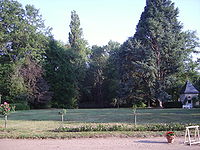
The museum of Sologne and the exposition of the servants
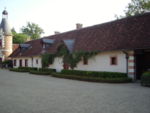
A permanent exposition on the domesticity of the 19th century, with documents of time, liveries
Livery
A livery is a uniform, insignia or symbol adorning, in a non-military context, a person, an object or a vehicle that denotes a relationship between the wearer of the livery and an individual or corporate body. Often, elements of the heraldry relating to the individual or corporate body feature in...
, and small tableaux are also preserved in the commons.
Anecdotes
